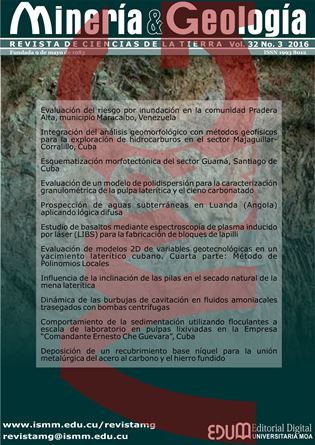Cavitation Bubble Dynamics in Ammoniacal Fluids Transferred by Centrifugal Pumps
Keywords:
centrifugal pumps, cavitation, bubble formation, flow patterns, ammoniacal liquor.Abstract
An experiment with water and ammoniacal liquor at 27% and 34% concentrations of ammonia was carried out in order to determine the pressure dynamics during the formation of bubbles and their movement when causing cavitations in centrifugal pumps. The dynamics of bubbles was calculated numerically by applying the Rayleigh-Plesset equation using the bubble radius and the bubble build-up time. It is concluded that the pressure to form the bubbles at 22 ºC is 10,135.103 Pa for water and 45,468.103 Pa for the ammoniacal liquor at a concentration of 34 %. The radius of the bubbles found in ammoniacal liquor is in the range of 30 to 120 times the original bubble radius while the bubbles formed in water are only in the range of 15 times the original radius value.Downloads
References
BARNES, P. A. & RIECKHOFF, K. E. 1968: Laser induced underwater sparks. Applied Physics Letters 13(8): 282-284.
BRENNEN, C. E. 2011: Hidrodynamics of Pumps. Cambridge University Press.
BRENNEN, C. E. 2013: Cavitation and bubble dynamics. Cambridge University Press.
CONDE, M. R. 2004: Thermophysical Properties of NH3 + H2O Solutions for the Industrial Design of Absorption Refrigeration Equipment. Revista Engineering 1-34 p.
DOPAZO, G. C. 2008: ¿Cavitar o no cavitar? La inevitable ubicuidad de las burbujas. Real Academia de España. Universidad de Zaragoza. Madrid. 50 p.
GONZÁLEZ, V. 1983: Hidráulica, bombas y compresores. Pueblo y Educación, Ciudad de La Habana.
FERZIGER, F. H. & PERÍC, M. 2002: Computational Methods for Fluid Dynamic. 3ra edition. Springer-Verlag, Berlin Heidelberg. 423 p.
REYES, J. L. 2010: Un experimento de enseñanza e investigación de la cavitación en bombas centrífugas. Asociación Americana de Profesores de Física 4(1): 2-18.
REYES, J. L.; RUIZ, G.; TORRES, E.; LAMBERT, R. & MATOS, M. 2015: Presión de saturación del licor amoniacal y su relación con el fenómeno de cavitación en bombas centrífugas. Minería y Geología 31(1): 111-129.
RAMÍREZ, R. G.; JÁCOME, M. & GIRALDO, A. J. 2013: Solución de la ecuación de Rayleigh-Plesset por medio del método del elemento finito. Ingeniería y Ciencia 9(17): 147-162.
PÉREZ, B. R. 2004: Cavitación y materiales de construcción en las Bombas Centrífugas. Minería y Geología 20(3-4): 114-118.
LEIGHTON, T. G. 2007: Derivation of the Rayleigh–Plesset equation in terms of volume. Institute of Sound and Vibration Research. University of Southampton.
LAUTERBORN, W. 1998: Termo cavitación y algunas aplicaciones. En: XIX Verano de la Investigación Científica de la Academia Mexicana de Ciencia. Instituto Nacional de Astrofísica y Electrónica. México.
RAYLEIGH, L. 1917: On the pressure developed in a liquid during the collapse of a spherical cavity. The London, Edinburgh, and Dublin Philosophical Magazine and Journal of Science 34(200): 94-98.
PLESSET, M. S. 1949: The dynamics of cavitation bubbles. Journal of applied mechanics 16: 277-282.
TANAKA, T. & TSUKAMOTO, H. 1999a: Transient behavior of a cavitating centrifugal pump at rapid change in operating conditions—Part 1: Transient phenomena at opening/closure of discharge valve. Journal of fluids engineering 121(4): 841-849.
TANAKA, T. & TSUKAMOTO, H. 1999b: Transient behavior of a cavitating centrifugal pump at rapid change in operating conditions—Part 2: Transient phenomena at pump startup/shutdown. Journal of fluids engineering 121(4): 850-856.
TANAKA, T. & TSUKAMOTO, H. 1999c: Transient behavior of a cavitating centrifugal pump at rapid change in operating conditions—Part 3: Classifications of transient phenomena. Journal of fluids engineering 121(4): 857-865.
TORRES, S. 2010: Generación de burbujas de cavitación con láser continuo para la formación de microagujeros en películas metálicas delgadas. Tesis doctoral.
Published
How to Cite
Issue
Section
Copyright (c) 2016 Jorge Reyes-Cruz, Gerardo Ruiz-Chavarría, Roilber Lambert-Sánchez, Alberto Turro-Breff, Enrique Torres-Tamayo, Sergio Hernández-Zapata

This work is licensed under a Creative Commons Attribution-NonCommercial 4.0 International License.
- Authors retain copyright and guaranteeing the right magazine to be the first publication of the work as licensed under a Creative Commons Attribution-NonCommercial that allows others to share the work with an acknowledgment of the work's authorship and initial publication in this journal.
- Authors may establish separate supplemental agreements for the exclusive distribution version of the work published in the journal (eg, place it in an institutional repository or publish it in a book), with an acknowledgment of its initial publication in this journal.
- Authors are allowed and recommended to disseminate their work through the Internet (e.g., in institutional telematic archives or on their websites) before and during the submission process, which can produce interesting exchanges and increase citations of the published work. (See The effect of open access)




